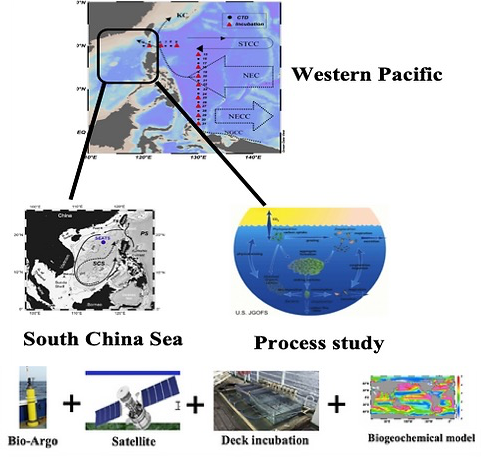Constraining Upper-Ocean Carbon Export with Biogeochemical Profiling Floats: Toward Persistent Training and Validation of Satellite Carbon Export Algorithms
I am currently working on an NSF-funded project associated with NASA EXPORTS that incorporates data from multiple biogeochemical profiling floats, a mooring, and ships in the eastern subarctic Pacific. We are using these data to constrain upper-ocean tracer budgets to quantify carbon cycling and export over multiple years. The goal of the project is to improve understanding of the biological carbon pump and its predictability from remote sensing.

For more information: Huang et al. 2022. Global Biogeochemical Cycles.
Biological Pump in the South China Sea and its Adjacent Western Pacific
My Ph.D. work centered around the biological pump in the highly dynamic South China Sea and the adjacent western Pacific by combining multiple approaches, including deck incubations, biogeochemical profiling float observations, numerical models, and marine-learning algorithms. For the first time, year-round net community production was estimated in the central South China Sea basin using high-frequency oxygen measurement from biogeochemical profiling floats (Huang et al., 2018, DSR-I).

Concurrent measurements of autotrophic and heterotrophic metabolic rates and inorganic nutrients pools were used to reveal a unique mechanism that fuels carbon export in the mixing zone of SCS and Kuroshio Current. We found during the water mixing, the dissolved organic matter horizontally transferred from the the Kuroshio Current Intrusion stimulates bacterial activity in SCS, and catabolism of these dissolved organic matter releases inorganic nutrients that subsequently stimulate primary production. Unlike the conventional pathway of nutrients supply via vertical mixing, this new nitrogen source serve as another mechanism to fuel export production and enhance the ability of carbon sequestration that stimulate primary production. Recognition of this mechanism underscores the role of horizontal currents in regional carbon and nitrogen cycles and broadens understanding of the processes that sustain export production in the oligotrophic ocean. (Huang et al., 2019, JGR-BG).
In addition, my synthesis analysis of metabolic rates from the deck incubations, empirical estimates based on the biomass and growth efficiency, and global biogeochemical models output revealed that the incubation approach may overestimate community respiration, resulting in an overestimation of heterotrophy through this method (Huang et al., 2019, L&O).
This series of studies has helped to shed light on the mechanisms controlling the biological pump and is variability. This work also contributes to the on-going debate regarding the metabolic state of the oligotrophic ocean.